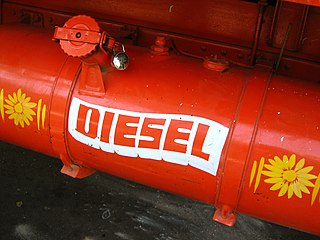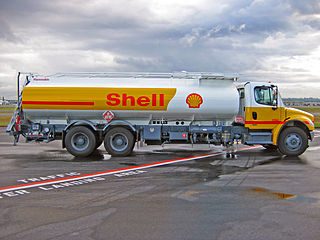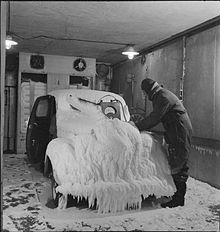
Diesel fuel, also called diesel oil, heavy oil (historically) or simply diesel, is any liquid fuel specifically designed for use in a diesel engine, a type of internal combustion engine in which fuel ignition takes place without a spark as a result of compression of the inlet air and then injection of fuel. Therefore, diesel fuel needs good compression ignition characteristics.
An octane rating, or octane number, is a standard measure of a fuel's ability to withstand compression in an internal combustion engine without causing engine knocking. The higher the octane number, the more compression the fuel can withstand before detonating. Octane rating does not relate directly to the power output or the energy content of the fuel per unit mass or volume, but simply indicates the resistance to detonating under pressure without a spark.

Biodiesel is a renewable biofuel, a form of diesel fuel, derived from biological sources like vegetable oils, animal fats, or recycled greases, and consisting of long-chain fatty acid esters. It is typically made from fats.

Motor oil, engine oil, or engine lubricant is any one of various substances used for the lubrication of internal combustion engines. They typically consist of base oils enhanced with various additives, particularly antiwear additives, detergents, dispersants, and, for multi-grade oils, viscosity index improvers. The main function of motor oil is to reduce friction and wear on moving parts and to clean the engine from sludge and varnish (detergents). It also neutralizes acids that originate from fuel and from oxidation of the lubricant (detergents), improves the sealing of piston rings, and cools the engine by carrying heat away from moving parts.

The flash point of a material is the "lowest liquid temperature at which, under certain standardized conditions, a liquid gives off vapours in a quantity such as to be capable of forming an ignitable vapour/air mixture".

Aviation fuels are petroleum-based fuels, or petroleum and synthetic fuel blends, used to power aircraft. They have more stringent requirements than fuels used for ground use, such as heating and road transport, and contain additives to enhance or maintain properties important to fuel performance or handling. They are kerosene-based for gas turbine-powered aircraft. Piston-engined aircraft use leaded gasoline and those with diesel engines may use jet fuel (kerosene). By 2012, all aircraft operated by the U.S. Air Force had been certified to use a 50-50 blend of kerosene and synthetic fuel derived from coal or natural gas as a way of stabilizing the cost of fuel.

Shell V-Power is the brand name given to Shell's enhanced high specification fuels for road motor vehicles including "Shell V-Power Nitro+" and "Shell V-Power Diesel". Introduced in Italy in 2001, Shell relaunched the fuel in March 2008, under the name Nitrogen-Enriched Shell V-Power, with nitrogen-containing detergents.
Cetane number (CN) is an indicator of the combustion speed of diesel fuel and compression needed for ignition. It plays a similar role for diesel as octane rating does for gasoline. The CN is an important factor in determining the quality of diesel fuel, but not the only one; other measurements of diesel fuel's quality include energy content, density, lubricity, cold-flow properties and sulfur content.

Jet fuel or aviation turbine fuel is a type of aviation fuel designed for use in aircraft powered by gas-turbine engines. It is colorless to straw-colored in appearance. The most commonly used fuels for commercial aviation are Jet A and Jet A-1, which are produced to a standardized international specification. The only other jet fuel commonly used in civilian turbine-engine powered aviation is Jet B, which is used for its enhanced cold-weather performance.
The viscosity index (VI) is an arbitrary, unit-less measure of a fluid's change in viscosity relative to temperature change. It is mostly used to characterize the viscosity-temperature behavior of lubricating oils. The lower the VI, the more the viscosity is affected by changes in temperature. The higher the VI, the more stable the viscosity remains over some temperature range. The VI was originally measured on a scale from 0 to 100; however, advancements in lubrication science have led to the development of oils with much higher VIs.
JP-8, or JP8, is a jet fuel, specified and used widely by the US military. It is specified by MIL-DTL-83133 and British Defence Standard 91-87, and similar to commercial aviation's Jet A-1, but with the addition of corrosion inhibitor and anti-icing additives.

A diesel particulate filter (DPF) is a device designed to remove diesel particulate matter or soot from the exhaust gas of a diesel engine.
Higher alkanes refer to alkanes with a high number of carbon atoms. There does not exist a formal definition for when an alkane is classified as a 'higher alkane', but one definition distinguishes the higher alkanes as the n-alkanes that are solid under room temperature.
In liquids, the cloud point is the temperature below which a transparent solution undergoes either a liquid-liquid phase separation to form an emulsion or a liquid-solid phase transition to form either a stable sol or a suspension that settles a precipitate. The cloud point is analogous to the 'dew point' at which a gas-liquid phase transition called condensation occurs in water vapour to form liquid water. When the temperature is below 0 °C, the dew point is called the frost point, as water vapour undergoes gas-solid phase transition called deposition, solidification, or freezing.
EN 14214 is a standard published by the European Committee for Standardization that describes the requirements and test methods for FAME - the most common type of biodiesel.
Neste MY Renewable Diesel is a vegetable oil refining fuel production process commercialized by the Finnish oil and refining company Neste. Whether as an admixture or in its pure form, the fuel is able to supplement or partially replace conventional diesel without problems. Neste guarantees that every gallon sold meets ASTM D975 and EN 15940 specifications in compliance with OEM standards.
EN 590 is a standard published by the European Committee for Standardization that describes the physical and chemical properties that all automotive diesel fuel must meet if it is to be sold in the European Union and several other European countries.
Cold filter plugging point (CFPP) is the lowest temperature, expressed in degrees Celsius (°C), at which a given volume of diesel type of fuel still passes through a standardized filtration device in a specified time when cooled under certain conditions. This test gives an estimate for the lowest temperature that a fuel will give trouble free flow in certain fuel systems. This is important as in cold temperate countries, a high cold filter plugging point will clog up vehicle engines more easily.
The gel point of petroleum products is the temperature at which the liquids gel so they no longer flow by gravity or can be pumped through fuel lines. This phenomenon happens when the petroleum product reaches a low enough temperature to precipitate interlinked paraffin wax crystals throughout the fluid.
A cetane improver [′sē‚tān im′prüv·ər] is a chemical which has the effect of increasing a diesel fuel's cetane number. A few examples are nitrates, nitroalkanes, nitrocarbonates and peroxides.








